
Richard Kogan, M.D.: Music, A Window to the Soul
by Pola Rosen, Ed.D.
Listening to Dr. Richard Kogan passionately perform the technically masterful passages of Chopin’s Polonaise at an interview at Weill Medical College of Cornell University recently, transported me to a state of rhapsody. Dr. Kogan, a psychiatrist and concert pianist who was a roommate of Yo-Yo Ma at Harvard (and still plays in trios with him and fellow classmate Lynn Chang), analyzes the tortured creativity of Tchaikovsky, Schumann and Gershwin through their letters, diaries, medical data and music.
While it’s hard to make other than tentative diagnoses on historical figures, Kogan explains, Tchaikovsky, writing 1300 letters to his patron, among others, clearly suffered from depression. Would he and Schumann, a victim of bipolar disorder, have been more productive if they had been able to take Prozac or Lithium? According to Dr. Kogan, there is a delicate balance between creativity and inner turmoil. Perhaps, he ventures, Tchaikovsky and Schumann would not have been as productive if they had taken mood stabilizers. Kogan is convincing as he poses this dilemma: the artists he treats in his practice as well as those in history would rather be creative and suffer than not be creative at all. Kogan cites Socrates as opining that creativity is only possible if an individual is out of his senses.
After Beethoven became deaf, catastrophic for anyone but particularly for a musician, he contemplated suicide. Kogan explains that Beethoven decided to devote himself to furthering his artistic expression and actually incorporated his suffering into his music. “He became a great composer because of and not in spite of [his deafness]. The ninth symphony, which speaks to us all, was written while he was deaf.”
In some cases, meaningful relationships helped to organize the musicians’ lives and root them. Kogan offers Clara Schumann, Robert Schumann’s partner and George Sand, Chopin’s lover as prime examples. Music can help people and alleviate their pain and suffering. Gershwin, for example, was a difficult behavior problem in school when he was about 11 years old. Those problems magically vanished when he was exposed to music. Shortly thereafter, as a teenager, he composed “Swannee River” which became an international hit. Later, very depressed, Gershwin’s music resonates with sadness illustrated by the lullaby “Summertime,” poignantly played by Kogan. Gershwin writes of a burning smell, clearly a neurological symptom, not picked up by his psychiatrist. The subsequent fatal brain tumor was not diagnosed until his untimely death, just a few years later. Expanding on the healing power of motivation and music, Kogan recalls how hard it was for him to memorize every bone in the foot for his Anatomy class in medical school, and conversely, how relatively easy it was to commit to memory, not only thousands of notes of music but also the numerous case histories of his patients.
In addition to motivation, a community of people making music together is key. As a young boy, Kogan remembers the isolation of playing alone in his home and being the only one in school to play an instrument. As a result, he rebelled against a strict practice schedule in his teenage years. Today, he has ensured that his three children play in the company of other musicians by having them learn string instruments. His oldest daughter, a cello student at Juilliard pre-college program, is attending a music camp this summer with numerous opportunities to perform with others.
Underscoring the important and challenging role of parents and educators to ensure that everyone has the ability to make music, Kogan affirms that music is indeed the universal language, that it breaks down barriers to a larger vision, that it enables people to become more creative and “think outside the box.” Yo-Yo Ma, he says, is an innovative thinker, always looking for new ways to interpret, create and expand music. Kogan feels strongly that music education should never be lost in the public schools. In higher education, in medical school, Kogan feels it becomes a tool for infusing a humanistic element into the medical school; it sharpens the diagnostic skill of students as well as sensitizing them to human suffering.
From Greek mythology flows the image of Apollo, the god of music and medicine, who fulfills the role of physician/healer and bridges the disciplines of music and medicine. Dr. Kogan, is our society’s modern day Apollo; we are fortunate to have him in our midst.#
